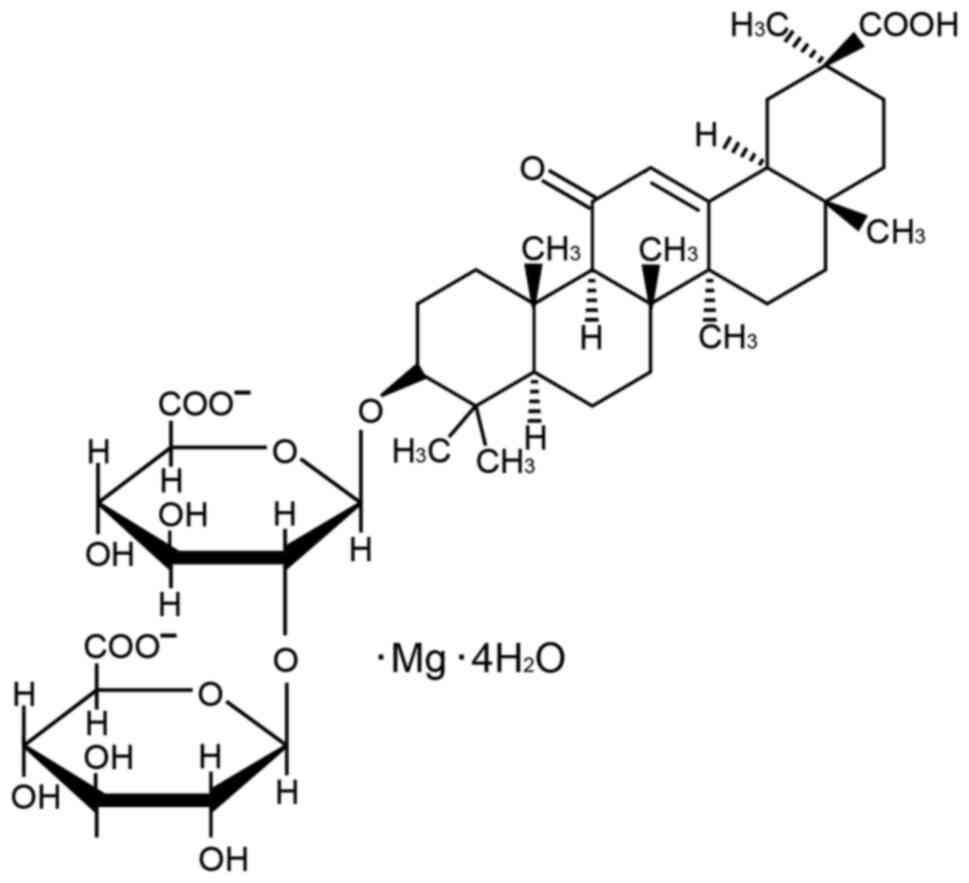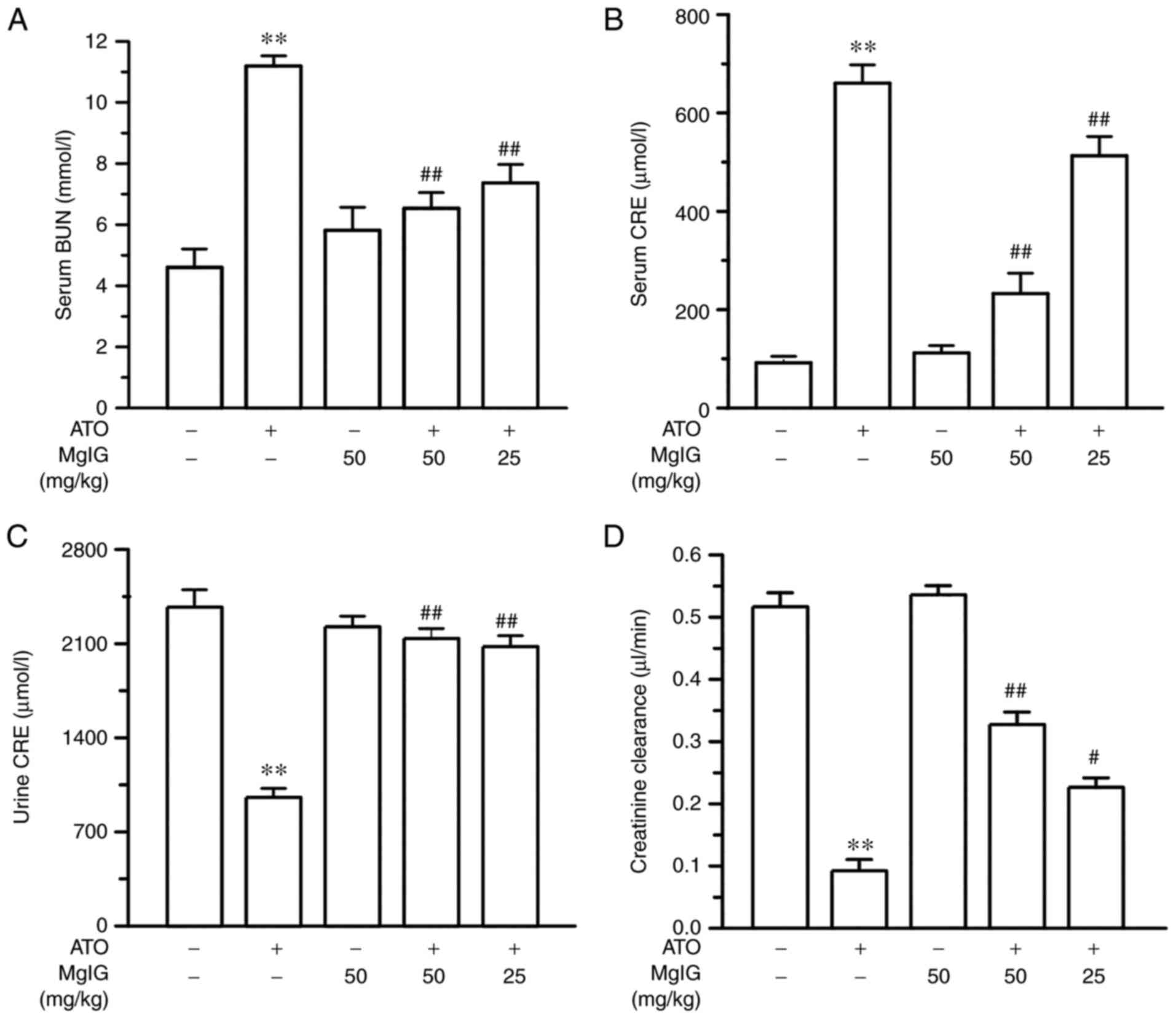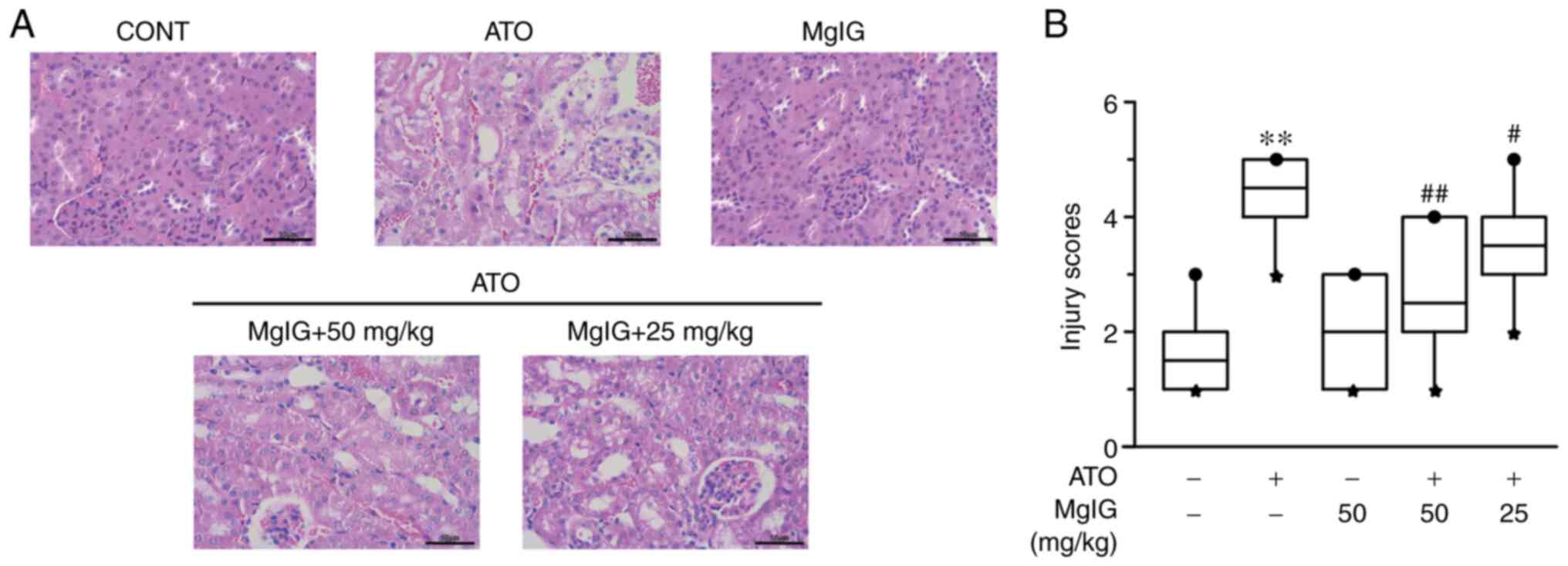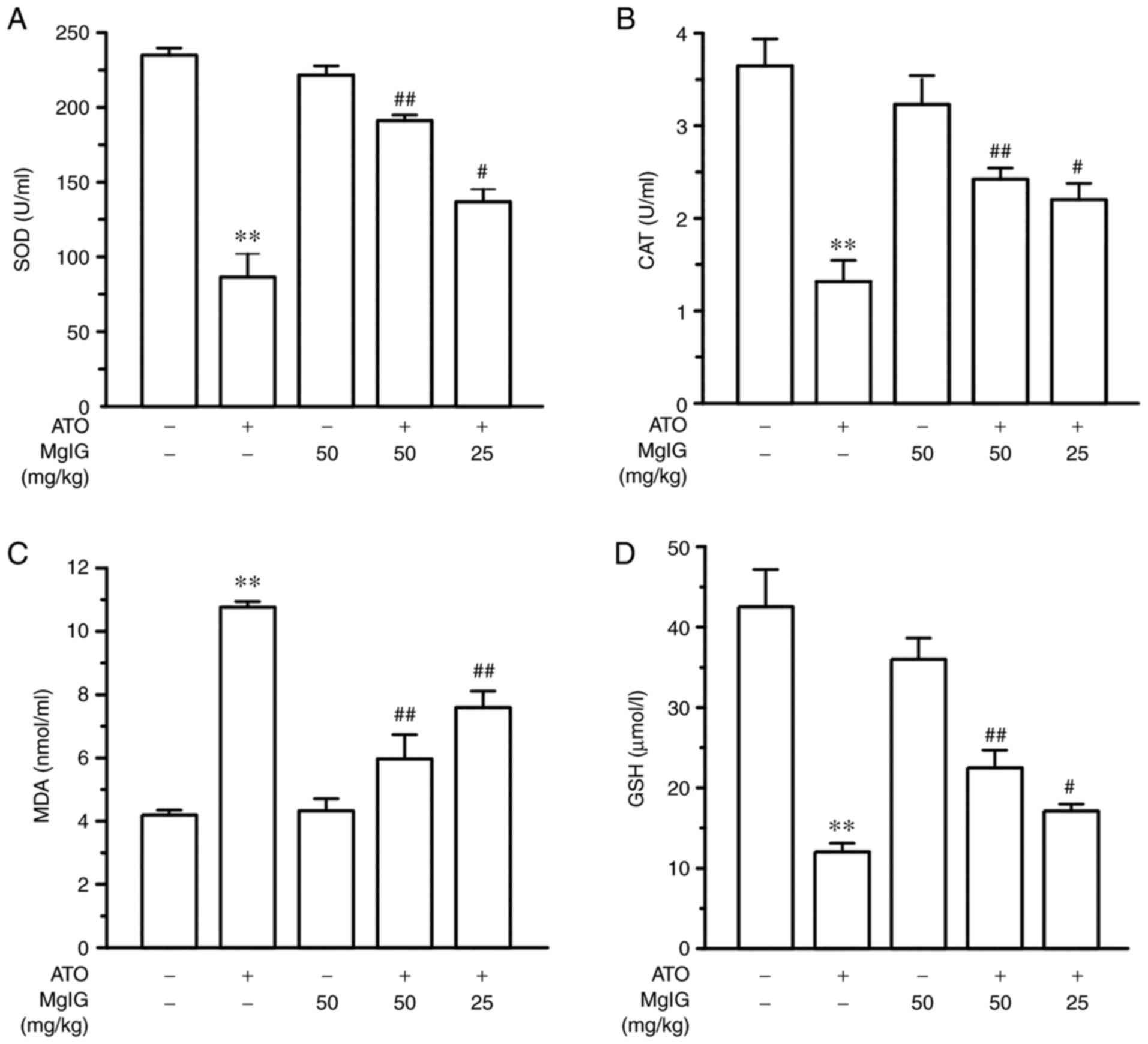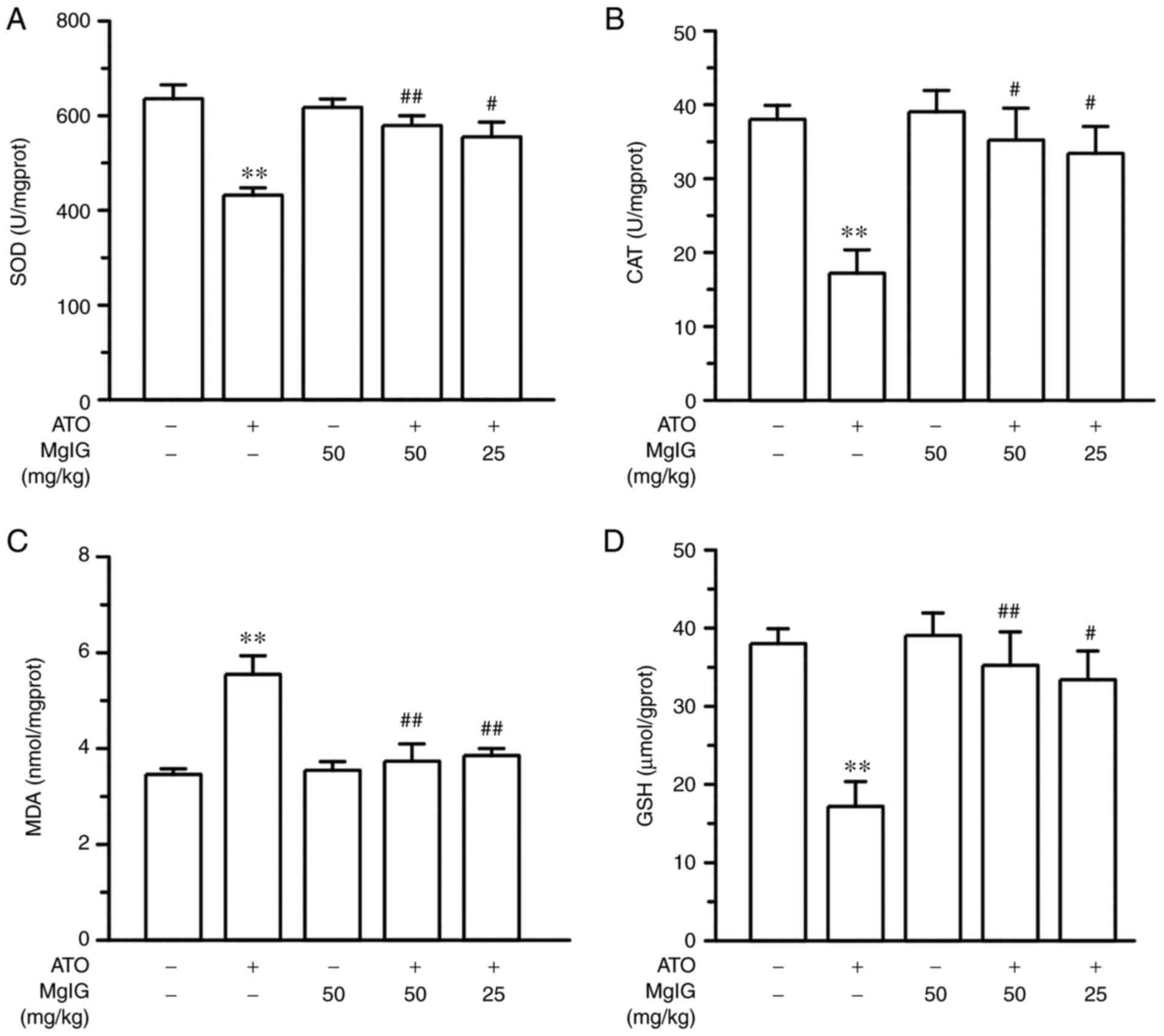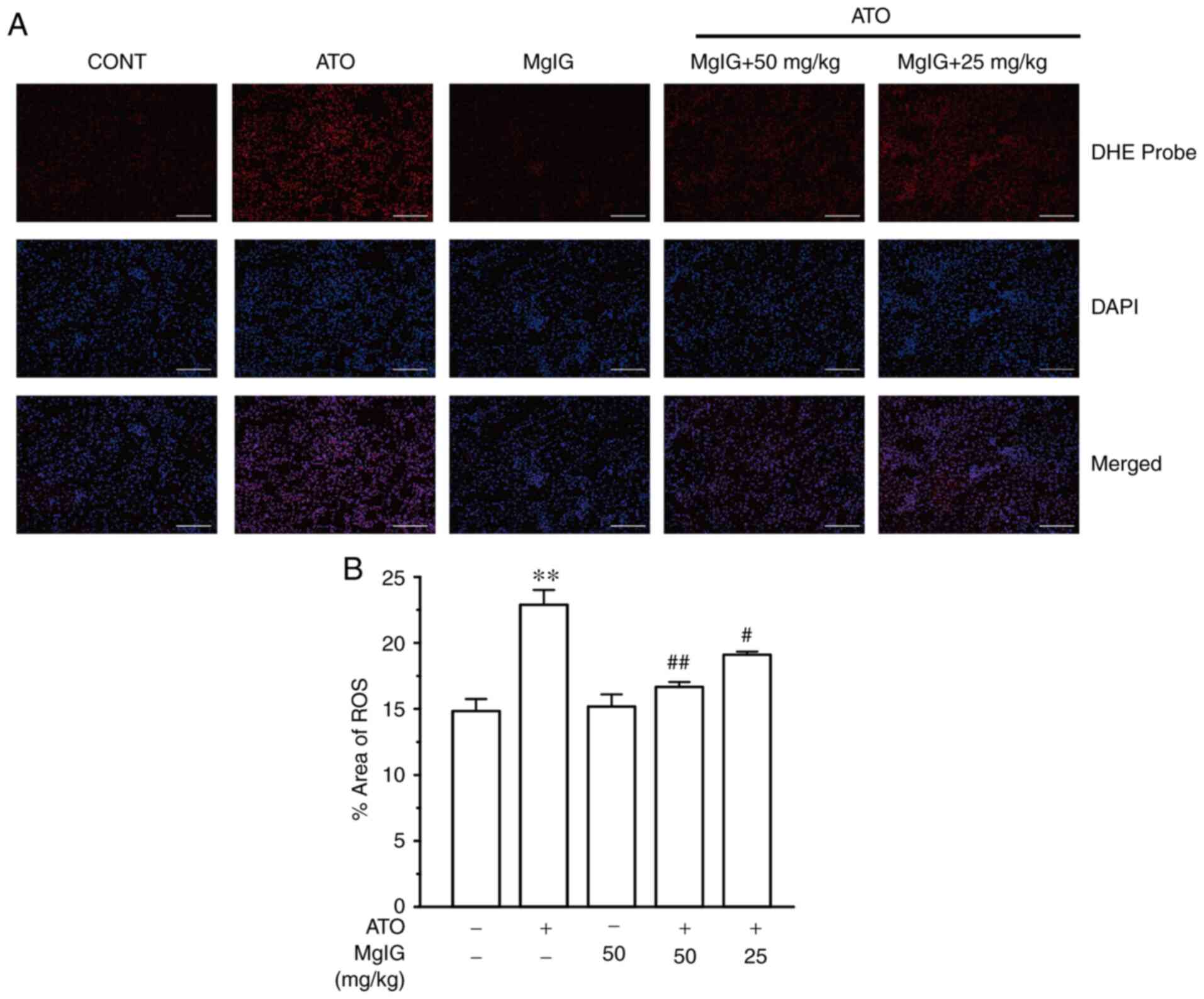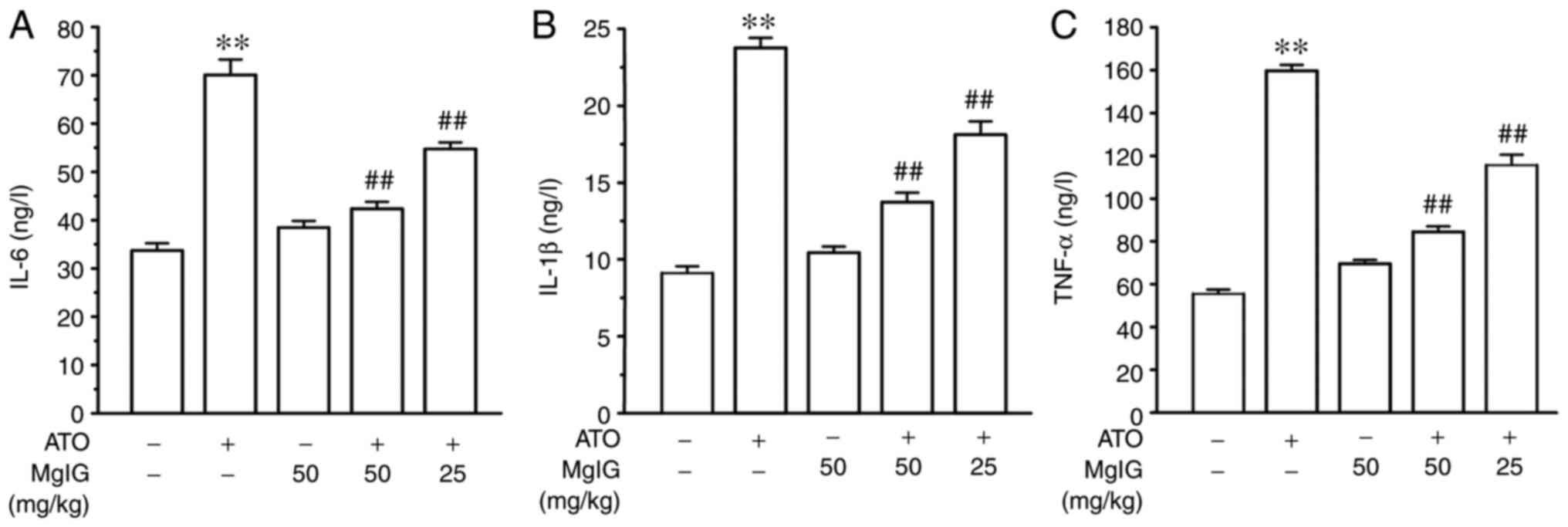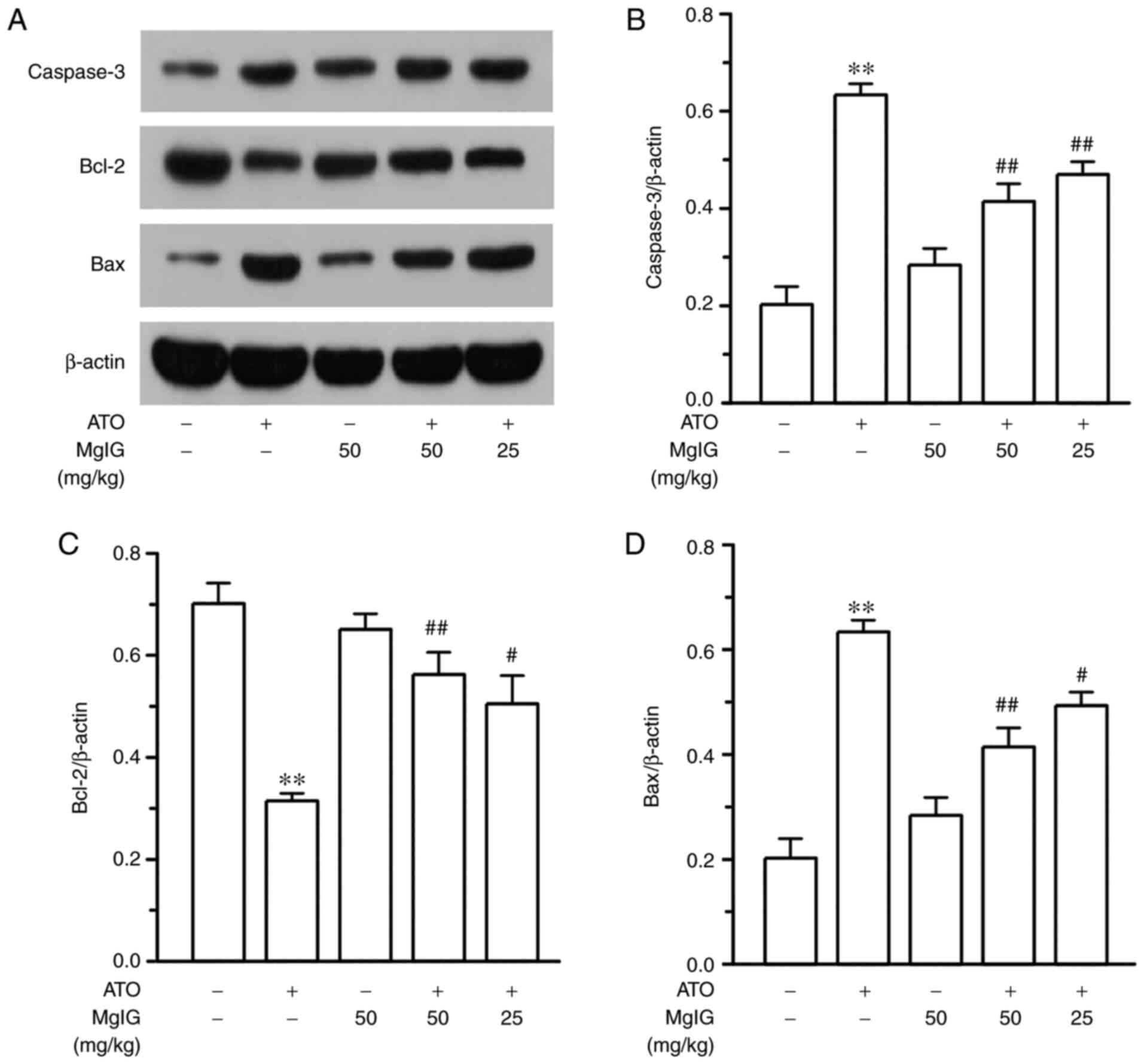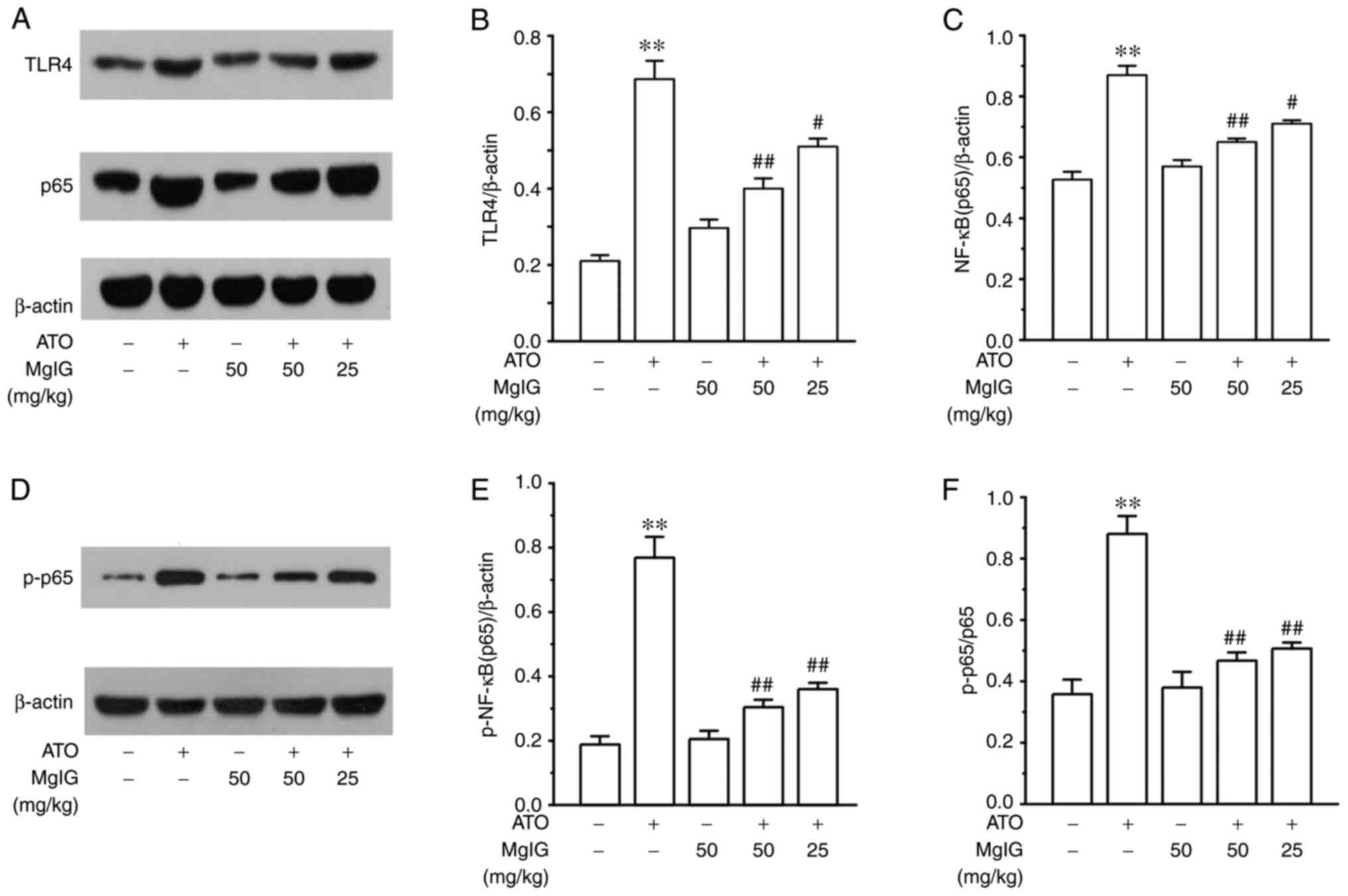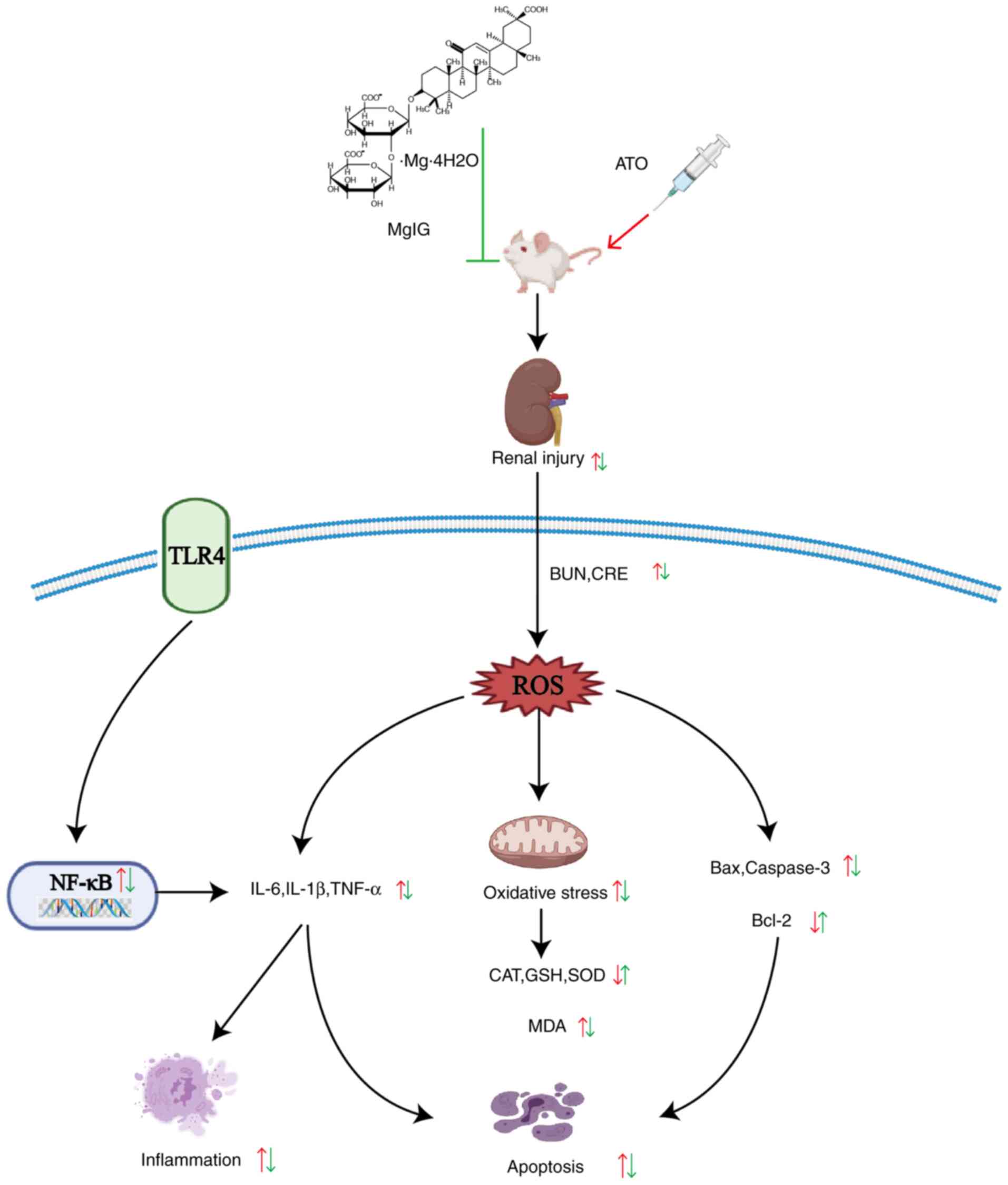|
1
|
Watanabe T and Hirano S: Metabolism of
arsenic and its toxicological relevance. Arch Toxicol. 87:969–979.
2013.PubMed/NCBI View Article : Google Scholar
|
|
2
|
Antman KH: Introduction: The history of
arsenic trioxide in cancer therapy. Oncologist. 6 (Suppl 2):S1–S2.
2001.PubMed/NCBI View Article : Google Scholar
|
|
3
|
Bao L and Shi H: Potential molecular
mechanisms for combined toxicity of arsenic and alcohol. J Inorg
Biochem. 104:1229–1233. 2010.PubMed/NCBI View Article : Google Scholar
|
|
4
|
You BR and Park WH: Arsenic trioxide
induces human pulmonary fibroblast cell death via increasing ROS
levels and GSH depletion. Oncol Rep. 28:749–757. 2012.PubMed/NCBI View Article : Google Scholar
|
|
5
|
Simon JP, Parthasarathy M, Nithyanandham
S, Katturaja RK, Namachivayam A and Prince SE: Protective effect of
the ethanolic and methanolic leaf extracts of madhuca longifolia
against diclofenac-induced toxicity in female wistar albino rats.
Pharmacol Rep. 71:983–993. 2019.PubMed/NCBI View Article : Google Scholar
|
|
6
|
Katturajan R and Evan Prince S: A role of
connexin 43 on the drug-induced liver, kidney, and gastrointestinal
tract toxicity with associated signaling pathways. Life Sci.
280(119629)2021.PubMed/NCBI View Article : Google Scholar
|
|
7
|
Zhang J, Pan X, Li N, Li X, Wang Y, Liu X,
Yin X and Yu Z: Grape seed extract attenuates arsenic-induced
nephrotoxicity in rats. Exp Ther Med. 7:260–266. 2014.PubMed/NCBI View Article : Google Scholar
|
|
8
|
Yu M, Xue J, Li Y, Zhang W, Ma D, Liu L
and Zhang Z: Resveratrol protects against arsenic trioxide-induced
nephrotoxicity by facilitating arsenic metabolism and decreasing
oxidative stress. Arch Toxicol. 87:1025–1035. 2013.PubMed/NCBI View Article : Google Scholar
|
|
9
|
Zhang W, Liu Y, Ge M, Jing J, Chen Y,
Jiang H, Yu H, Li N and Zhang Z: Protective effect of resveratrol
on arsenic trioxide-induced nephrotoxicity in rats. Nutr Res Pract.
8:220–226. 2014.PubMed/NCBI View Article : Google Scholar
|
|
10
|
Shi H, Shi X and Liu K: Oxidative
mechanism of arsenic toxicity and carcinogenesis. Mol Cell Biochem.
255:67–78. 2004.PubMed/NCBI View Article : Google Scholar
|
|
11
|
Lushchak VI: Free radicals, reactive
oxygen species, oxidative stress and its classification. Chem Biol
Interact. 224:164–175. 2014.PubMed/NCBI View Article : Google Scholar
|
|
12
|
Avlas O, Fallach R, Shainberg A, Porat E
and Hochhauser E: Toll-like receptor 4 stimulation initiates an
inflammatory response that decreases cardiomyocyte contractility.
Antioxid Redox Signal. 15:1895–1909. 2011.PubMed/NCBI View Article : Google Scholar
|
|
13
|
Tang J, Xu L, Zeng Y and Gong F: Effect of
gut microbiota on LPS-induced acute lung injury by regulating the
TLR4/NF-kB signaling pathway. Int Immunopharmacol.
91(107272)2021.PubMed/NCBI View Article : Google Scholar
|
|
14
|
Mir SM, Ravuri HG, Pradhan RK, Narra S,
Kumar JM, Kuncha M, Kanjilal S and Sistla R: Ferulic acid protects
lipopolysaccharide-induced acute kidney injury by suppressing
inflammatory events and upregulating antioxidant defenses in Balb/c
mice. Biomed Pharmacother. 100:304–315. 2018.PubMed/NCBI View Article : Google Scholar
|
|
15
|
Feng D, Wang Y, Liu Y, Wu L, Li X, Chen Y,
Chen Y, Chen Y, Xu C, Yang K and Zhou T: DC-SIGN reacts with TLR-4
and regulates inflammatory cytokine expression via NF-κB activation
in renal tubular epithelial cells during acute renal injury. Clin
Exp Immunol. 191:107–115. 2018.PubMed/NCBI View Article : Google Scholar
|
|
16
|
Zhong G, Wan F, Ning Z, Wu S, Jiang X,
Tang Z, Huang R and Hu L: The protective role of autophagy against
arsenic trioxide-induced cytotoxicity and ROS-dependent pyroptosis
in NCTC-1469 cells. J Inorg Biochem. 217(111396)2021.PubMed/NCBI View Article : Google Scholar
|
|
17
|
Farooq MA, Niazi AK, Akhtar J, Saifullah
Farooq M, Souri Z, Karimi N and Rengel Z: Acquiring control: The
evolution of ROS-induced oxidative stress and redox signaling
pathways in plant stress responses. Plant Physiol Biochem.
141:353–369. 2019.PubMed/NCBI View Article : Google Scholar
|
|
18
|
Roy A, Manna P and Sil PC: Prophylactic
role of taurine on arsenic mediated oxidative renal dysfunction via
MAPKs/NF-kappaB and mitochondria dependent pathways. Free Radic
Res. 43:995–1007. 2009.PubMed/NCBI View Article : Google Scholar
|
|
19
|
Nandi D, Patra RC and Swarup D: Oxidative
stress indices and plasma biochemical parameters during oral
exposure to arsenic in rats. Food Chem Toxicol. 44:1579–1584.
2006.PubMed/NCBI View Article : Google Scholar
|
|
20
|
Zhang K, Zhao P, Guo G, Guo Y, Tian L, Sun
X, Li S, He Y, Sun Y, Chai H, et al: Arsenic trioxide attenuates
NF-κB and cytokine mRNA levels in the livers of cocks. Biol Trace
Elem Res. 170:432–437. 2016.PubMed/NCBI View Article : Google Scholar
|
|
21
|
Zheng B, Yang Y, Li J, Li J, Zuo S, Chu X,
Xu S, Ma D and Chu L: Magnesium isoglycyrrhizinate alleviates
arsenic trioxide-induced cardiotoxicity: Contribution of Nrf2 and
TLR4/NF-κB signaling pathway. Drug Des Devel Ther. 15:543–556.
2021.PubMed/NCBI View Article : Google Scholar
|
|
22
|
Yang YZ, Liu ZH, Wang SC, Zhang XQ, Xu HJ,
Yang L and Kong LD: Magnesium isoglycyrrhizinate alleviates
fructose-induced liver oxidative stress and inflammatory injury
through suppressing NOXs. Eur J Pharmacol.
883(173314)2020.PubMed/NCBI View Article : Google Scholar
|
|
23
|
Zhao Z, Tang Z, Zhang W, Liu J and Li B:
Magnesium isoglycyrrhizinate protects against
renal-ischemia-reperfusion injury in a rat model via
anti-inflammation, anti-oxidation and anti-apoptosis. Mol Med Rep.
16:3627–3633. 2017.PubMed/NCBI View Article : Google Scholar
|
|
24
|
Zheng J, Wu G, Hu GX, Peng YZ and Xiong
XJ: Protective effects against and potential mechanisms underlying
the effect of magnesium isoglycyrrhizinate in hypoxia-reoxygenation
injury in rat liver cells. Genet Mol Res. 14:15453–15461.
2015.PubMed/NCBI View Article : Google Scholar
|
|
25
|
Ma D, Zhang J, Zhang Y, Zhang X, Han X,
Song T, Zhang Y and Chu L: Inhibition of myocardial hypertrophy by
magnesium isoglycyrrhizinate through the TLR4/NF-κB signaling
pathway in mice. Int Immunopharmacol. 55:237–244. 2018.PubMed/NCBI View Article : Google Scholar
|
|
26
|
Liao Y, Tan RZ, Li JC, Liu TT, Zhong X,
Yan Y, Yang JK, Lin X, Fan JM and Wang L: Isoliquiritigenin
attenuates UUO-induced renal inflammation and fibrosis by
inhibiting mincle/Syk/NF-Kappa B signaling pathway. Drug Des Devel
Ther. 14:1455–1468. 2020.PubMed/NCBI View Article : Google Scholar
|
|
27
|
Percie du Sert N, Ahluwalia A, Alam S,
Avey MT, Baker M, Browne WJ, Clark A, Cuthill IC, Dirnagl U,
Emerson M, et al: Reporting animal research: Explanation and
elaboration for the ARRIVE guidelines 2.0. PLoS Biol.
18(e3000411)2020.PubMed/NCBI View Article : Google Scholar
|
|
28
|
Liu M, Zheng B, Liu P, Zhang J, Chu X,
Dong C, Shi J, Liang Y, Chu L, Liu Y and Han X: Exploration of the
hepatoprotective effect and mechanism of magnesium
isoglycyrrhizinate in mice with arsenic trioxide-induced acute
liver injury. Mol Med Rep. 23(438)2021.PubMed/NCBI View Article : Google Scholar
|
|
29
|
Li SG, Xu SZ, Niu Q, Ding YS, Pang LJ, Ma
RL, Jing MX, Wang K, Ma XM, Feng GL, et al: Lutein alleviates
arsenic-induced reproductive toxicity in male mice via Nrf2
signaling. Hum Exp Toxicol. 35:491–500. 2016.PubMed/NCBI View Article : Google Scholar
|
|
30
|
Jiang W, Chen Q, Li P, Lu Q, Pei X, Sun Y,
Wang G and Hao K: Magnesium Isoglycyrrhizinate attenuates
lipopolysaccharide-induced depressive-like behavior in mice. Biomed
Pharmacother. 86:177–184. 2017.PubMed/NCBI View Article : Google Scholar
|
|
31
|
Jiang W, Guo H, Su D, Xu H, Gu H and Hao
K: Ameliorative effect of magnesium isoglycyrrhizinate on hepatic
encephalopathy by epirubicin. Int Immunopharmacol.
75(105774)2019.PubMed/NCBI View Article : Google Scholar
|
|
32
|
Laferriere CA, Leung VS and Pang DS:
Evaluating intrahepatic and intraperitoneal sodium pentobarbital or
ethanol for mouse euthanasia. J Am Assoc Lab Anim Sci. 59:264–268.
2020.PubMed/NCBI View Article : Google Scholar
|
|
33
|
Kim HY, Yokozawa T, Nakagawa T and Sasaki
S: Protective effect of gamma-aminobutyric acid against
glycerol-induced acute renal failure in rats. Food Chem Toxicol.
42:2009–2014. 2004.PubMed/NCBI View Article : Google Scholar
|
|
34
|
Tonomura Y, Yamamoto E, Kondo C, Itoh A,
Tsuchiya N, Uehara T and Baba T: Amphotericin B-induced
nephrotoxicity: Characterization of blood and urinary biochemistry
and renal morphology in mice. Hum Exp Toxicol. 28:293–300.
2009.PubMed/NCBI View Article : Google Scholar
|
|
35
|
Elliott AC and Hynan LS: A SAS(®) macro
implementation of a multiple comparison post hoc test for a
Kruskal-Wallis analysis. Comput Methods Programs Biomed. 102:75–80.
2011.PubMed/NCBI View Article : Google Scholar
|
|
36
|
Yazdani M: Concerns in the application of
fluorescent probes DCDHF-DA, DHR 123 and DHE to measure reactive
oxygen species in vitro. Toxicol In Vitro. 30:578–582.
2015.PubMed/NCBI View Article : Google Scholar
|
|
37
|
Ferreccio C, Smith AH, Durán V, Barlaro T,
Benítez H, Valdés R, Aguirre JJ, Moore LE, Acevedo J, Vásquez MI,
et al: Case-control study of arsenic in drinking water and kidney
cancer in uniquely exposed Northern Chile. Am J Epidemiol.
178:813–818. 2013.PubMed/NCBI View Article : Google Scholar
|
|
38
|
Surdu S, Fitzgerald EF, Bloom MS, Boscoe
FP, Carpenter DO, Haase RF, Gurzau E, Rudnai P, Koppova K, Févotte
J, et al: Occupational exposure to arsenic and risk of nonmelanoma
skin cancer in a multinational European study. Int J Cancer.
133:2182–2191. 2013.PubMed/NCBI View Article : Google Scholar
|
|
39
|
Zhao XJ, Yang YZ, Zheng YJ, Wang SC, Gu
HM, Pan Y, Wang SJ, Xu HJ and Kong LD: Magnesium isoglycyrrhizinate
blocks fructose-induced hepatic NF-κB/NLRP3 inflammasome activation
and lipid metabolism disorder. Eur J Pharmacol. 809:141–150.
2017.PubMed/NCBI View Article : Google Scholar
|
|
40
|
Gora RH, Kerketta P, Baxla SL, Toppo R,
Prasad R, Patra PH and Roy BK: Ameliorative effect of tephrosia
purpurea in arsenic-induced nephrotoxicity in rats. Toxicol Int.
21:78–83. 2014.PubMed/NCBI View Article : Google Scholar
|
|
41
|
Wang X, Zhao H, Shao Y, Wang P, Wei Y,
Zhang W, Jiang J, Chen Y and Zhang Z: Nephroprotective effect of
astaxanthin against trivalent inorganic arsenic-induced renal
injury in wistar rats. Nutr Res Pract. 8:46–53. 2014.PubMed/NCBI View Article : Google Scholar
|
|
42
|
Dutta S, Saha S, Mahalanobish S, Sadhukhan
P and Sil PC: Melatonin attenuates arsenic induced nephropathy via
the regulation of oxidative stress and inflammatory signaling
cascades in mice. Food Chem Toxicol. 118:303–316. 2018.PubMed/NCBI View Article : Google Scholar
|
|
43
|
Kumar S, Yedjou CG and Tchounwou PB:
Arsenic trioxide induces oxidative stress, DNA damage, and
mitochondrial pathway of apoptosis in human leukemia (HL-60) cells.
J Exp Clin Cancer Res. 33(42)2014.PubMed/NCBI View Article : Google Scholar
|
|
44
|
Schieber M and Chandel NS: ROS function in
redox signaling and oxidative stress. Curr Biol. 24:R453–R462.
2014.PubMed/NCBI View Article : Google Scholar
|
|
45
|
Wang Y, Zhao H, Shao Y, Liu J, Li J and
Xing M: Copper or/and arsenic induce oxidative stress-cascaded,
nuclear factor kappa B-dependent inflammation and immune imbalance,
trigging heat shock response in the kidney of chicken. Oncotarget.
8:98103–98116. 2017.PubMed/NCBI View Article : Google Scholar
|
|
46
|
Lushchak VI: Classification of oxidative
stress based on its intensity. EXCLI J. 13:922–937. 2014.PubMed/NCBI
|
|
47
|
Kumar P, Sulakhiya K, Barua CC and Mundhe
N: TNF-α, IL-6 and IL-10 expressions, responsible for disparity in
action of curcumin against cisplatin-induced nephrotoxicity in
rats. Mol Cell Biochem. 431:113–122. 2017.PubMed/NCBI View Article : Google Scholar
|
|
48
|
Jiang L, Liu Y, He P, Chen J, Liu S and
Tan N: Geraniin ameliorates cisplatin-induced nephrotoxicity in
mice. Free Radic Res. 50:813–819. 2016.PubMed/NCBI View Article : Google Scholar
|
|
49
|
Abou-Hany HO, Atef H, Said E, Elkashef HA
and Salem HA: Crocin mediated amelioration of oxidative burden and
inflammatory cascade suppresses diabetic nephropathy progression in
diabetic rats. Chem Biol Interact. 284:90–100. 2018.PubMed/NCBI View Article : Google Scholar
|
|
50
|
Xie C, Li X, Wu J, Liang Z, Deng F, Xie W,
Zhu M, Zhu J, Zhu W, Geng S and Zhong C: Anti-inflammatory activity
of magnesium isoglycyrrhizinate through inhibition of phospholipase
A2/Arachidonic acid pathway. Inflammation. 38:1639–1648.
2015.PubMed/NCBI View Article : Google Scholar
|
|
51
|
Lin G, Nnane IP and Cheng TY: The effects
of pretreatment with glycyrrhizin and glycyrrhetinic acid on the
retrorsine-induced hepatotoxicity in rats. Toxicon. 37:1259–1270.
1999.PubMed/NCBI View Article : Google Scholar
|
|
52
|
Wang YL, Wang CY, Zhang BJ and Zhang ZZ:
Shenfu injection suppresses apoptosis by regulation of Bcl-2 and
caspase-3 during hypoxia/reoxygenation in neonatal rat
cardiomyocytes in vitro. Mol Biol Rep. 36:365–370. 2009.PubMed/NCBI View Article : Google Scholar
|
|
53
|
Pratheeshkumar P and Kuttan G: Oleanolic
acid induces apoptosis by modulating p53, Bax, Bcl-2 and caspase-3
gene expression and regulates the activation of transcription
factors and cytokine profile in B16F. J Environ Pathol Toxicol
Oncol. 30:21–31. 2011.PubMed/NCBI View Article : Google Scholar
|
|
54
|
Lagos D, Vart RJ, Gratrix F, Westrop SJ,
Emuss V, Wong PP, Robey R, Imami N, Bower M, Gotch F and Boshoff C:
Toll-like receptor 4 mediates innate immunity to Kaposi sarcoma
herpesvirus. Cell Host Microbe. 4:470–483. 2008.PubMed/NCBI View Article : Google Scholar
|
|
55
|
Du Y, Qian B, Gao L, Tan P, Chen H, Wang
A, Zheng T, Pu S, Xia X and Fu W: Aloin preconditioning attenuates
hepatic ischemia/reperfusion injury via inhibiting TLR4/MyD88/NF-κB
signal pathway in vivo and in vitro. Oxid Med Cell Longev.
2019(3765898)2019.PubMed/NCBI View Article : Google Scholar
|
|
56
|
Elsharkawy AM and Mann DA: Nuclear
factor-kappaB and the hepatic inflammation-fibrosis-cancer axis.
Hepatology. 46:590–597. 2007.PubMed/NCBI View Article : Google Scholar
|
|
57
|
Song J, Fan H, Li H, Ding H, Lv Q and Hou
S: Zingerone ameliorates lipopolysaccharide-induced acute kidney
injury by inhibiting Toll-like receptor 4 signaling pathway. Eur J
Pharmacol. 772:108–114. 2016.PubMed/NCBI View Article : Google Scholar
|















